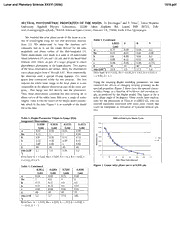
Spectral Photometric Properties of the Moon PDF
Preview Spectral Photometric Properties of the Moon
Lunar and Planetary Science XXXVI (2005) 1978.pdf SECTRAL PHOTOMETRIC PROPERTIES OF THE MOON. D. Domingue1 and F. Vilas2, 1Johns Hopkins University Applied Physics Laboratory, 11100 Johns Hopkins Rd, Laurel MD 20723, Deb- [email protected], 2NASA Johnson Space Center, Houston TX, 77058, [email protected] We modeled the solar phase curves of the moon at a se- ries of wavelengths using the full disk telescopic observa- Table 1. Continued 1.0635 U B V tions [1]. We endeavored to keep the database self- (µm) contained, that is, to use the values derived for the solar w 0.77 0.38 0.69 0.2 magnitude and phase curves of the disk-integrated [1]. Bo 0.23 0.01 0.49 0.98 These observations were made in a suite of 10 narrowband h 0.8 0.18 0.44 0.3 filters between 0.315 µm and 1.06 µm, and in the broad band b 0.63 0.52 0.52 0.35 Johnson UBV filters, as part of a larger program to obtain c 0.94 0.85 0.88 0.795 photoelectric photometry of the larger planets. Two aspects θ 40 40 40 40 of the lunar observations are unique. First, the observations rms (x10-5) 33.9 2.6 17.5 1.4 cover phase angles from 6o through 120o. More importantly, Error bars: w = ± 0.02, Bo = ± 0.05, h = ± 0.2, b = ± 0.02, c the observers used a special 20-mm diameter f/15 fused = ± 0.02, θ = ± 5 quartz lens constructed solely for this purpose. The lens Using the resulting Hapke modeling parameters we then reduced the whole lunar image in the focal plane to a size examined the affects of changing viewing geometry on the comparable to the planets observed as part of the same pro- spectral properties. Figure 2 shows how the spectral charac- gram. This image was fed directly into the photometer. teristics change as a function of incidence and emission an- Thus, these observations constitute the only existing set of gle, as predicted by the Hapke model. This figure is for a phase curves of the entire lunar disk over a range of wave- solar phase angle of 30 degrees. These results have implica- lengths. Table 1 lists the values of the Hapke model parame- tions for the predictions of Vilas et al (2005) [2], who see ters which fit the data. Figure 1 is an example of the model spectral signatures associated with some polar craters that could be interpreted as indicative of hydrated mineral spe- fits to the data. cies. Table 1. Hapke Parameter Values to Lunar Disk- 3590 nm Filter Lunar Phase Curve integrated Observations 0.07 0.3590 0.3926 0.4155 0.4573 (µm) (µm) (µm) (µm) 0.06 w 0.37 0.33 0.25 0.39 0.05 Bo 0.11 1 1 0.86 F) h 0.8 0.26 0.12 0.18 nce (I/0.04 data b 0.52 0.39 0.99 0.41 ecta0.03 fit c 0.87 0.83 1 0.83 Refl θ 40 40 40 40 0.02 rms (x10- 2.1 3.8 0.26 3.2 0.01 5) 0 Error bars: w = ± 0.02, Bo = ± 0.05, h = ± 0.2, b = ± 0.02, c 0 20 40 60 80 100 120 140 = ± 0.02, θ = ± 5 Solar Phase Angle (degrees) Figure 1. Lunar solar phase curve at 0.359 µm. Table 1. Continued. 0.5012 0.6264 0.7297 0.8595 (µm) (µm) (µm) (µm) w 0.34 0.66 0.71 0.60 Bo 1 0.6 0 0 h 0.13 0.37 n/a n/a b 0.31 0.59 0.6 0.63 c 0.66 0.94 0.91 0.91 θ 40 40 40 35 rms (x10- 5.2 2.7 27.6 146 5) Error bars: w = ± 0.02, Bo = ± 0.05, h = ± 0.2, b = ± 0.02, c = ± 0.02, θ = ± 5 Lunar and Planetary Science XXXVI (2005) 1978.pdf Spectra versus Geometry 0.13 0.12 i=15 0.11 i=17 0.1 i=10 Reflectance (I/F)0000....00006789 iiiiii======22211924742 0.05 i=7 0.04 i=5 0.03 3500 4500 5500 6500 7500 8500 9500 10500 Wavelength (nm) Figure 2. Model lunar spectra at 30◦ solar phase with varying incidence and emission angle (assumes angles are in-plane). References: Use the brief numbered style common in many abstracts, e.g., [1], [2], etc. References should then appear in numerical order in the reference list, and should use the following abbreviated style: [1] Lane, A. P., W. M. Irvine, 1973. Monochromatic phase curves and albedos for the lunar disk. Astron. J. 78, 267 – 277. [2] Vilas, Faith, Deborah L. Domingue, Elizabeth A. Jensen, Lucy A. McFadden, Cassandra R. Runyon, and Wendell W. Mendell, 2005. Phylosilicates near the lunar south pole. Inn preparation. . Additional Inform ation: If you have any questions or need addi- tional information regarding the preparation of your abstract, call the LPI at 281-486-2142 or -2188 (or send an e-mail message to publish@ lpi.usra.edu).
